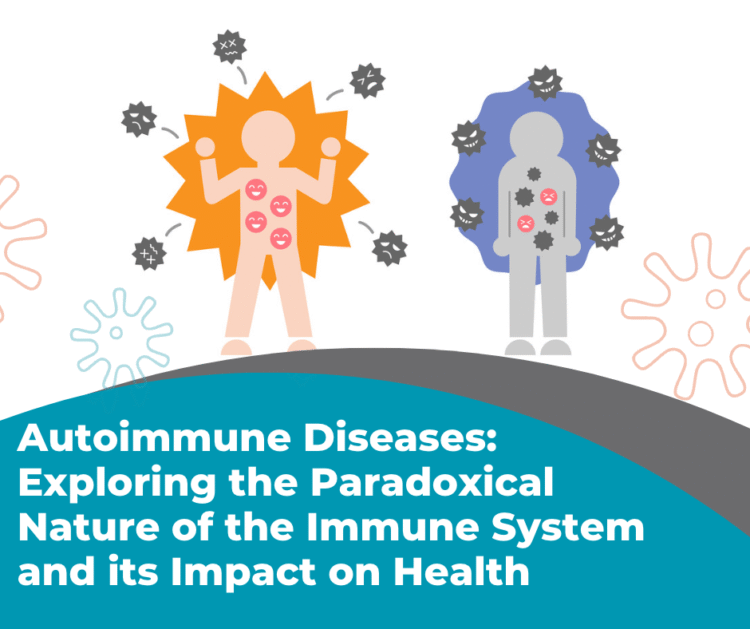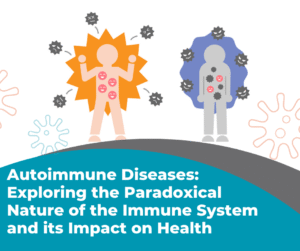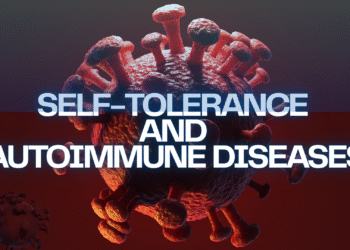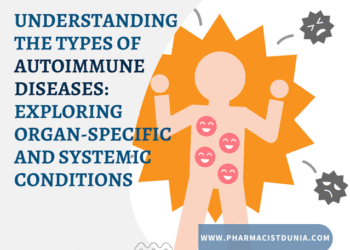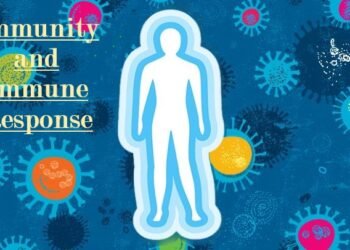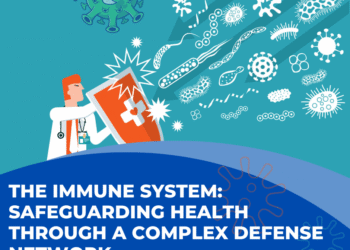Imagine a defense system so sophisticated that it can protect you from countless dangers, yet has the potential to turn against you. Step into the enigmatic realm of autoimmune diseases, where the immune system‘s intricate dance between safeguarding and self-destruction leaves scientists and medical professionals awe-inspired. Join us on a journey to unravel the paradoxical nature of the immune system and delve into the mysteries of autoimmune diseases that continue to astound and challenge our understanding of the human body.
The human body conceals an endless enigma, and unraveling this mystery can be both captivating and invaluable. Exploring the intricate workings of our own bodies is essential if we seek to comprehend the myriad phenomena unfolding around us. In this context, understanding autoimmune diseases is particularly enlightening. Today, we will delve into the fascinating realm of autoimmune diseases—a medical condition capable of astounding anyone.
The Intricate World of Autoimmune Diseases
Explore the fascinating and intricate world of autoimmune diseases, where the immune system‘s paradoxical nature becomes the source of both protection and harm. Unravel the mysteries of how our immune system can mistakenly attack our own cells and tissues, leading to a range of autoimmune conditions. Discover the latest research and insights into these complex diseases, and gain a deeper understanding of their impact on health and the ongoing efforts to find effective treatments.
Abstract:
Autoimmune diseases are a complex group of medical conditions characterized by the immune system‘s failure to distinguish between self and non-self, resulting in an immune response against the body’s own cells and tissues. This comprehensive article explores the immune system’s crucial role in maintaining overall health, the paradoxical nature of the immune system as both a protector and a potential source of diseases, and the intricate mechanisms underlying autoimmune diseases. It discusses the criteria used to identify autoimmune diseases, the specific target tissues and organs affected, and the current understanding of their causes and triggers. The article highlights the ongoing research efforts to develop personalized diagnostics, targeted therapies, and interventions for restoring immune balance. By unraveling the mysteries of autoimmune diseases, we gain valuable insights into the complexities of the human body, fostering a deeper appreciation for immune function and empowering individuals to seek appropriate medical care and take proactive steps in maintaining their health.
The Immune System and its Role
To fully understand autoimmune diseases, it is essential to delve into the concept of the immune system and its critical role in maintaining our overall health. The immune system serves as an intricate defense mechanism, acting as a safeguard against a wide array of pathogens and foreign particles that could potentially harm our bodies.
When we come into contact with various infectious agents, such as bacteria, viruses, or fungi, our immune system springs into action. It deploys a series of sophisticated mechanisms to detect, neutralize, and eliminate these pathogens, effectively preventing them from causing harm or illness.
The immune system consists of a complex network of specialized cells, proteins, and organs working together in harmony. Key players in this defense system include white blood cells, such as phagocytes and lymphocytes, which serve different functions in the immune response. Phagocytes engulf and digest foreign particles, while lymphocytes coordinate specific immune responses and produce antibodies that target and neutralize specific antigens.
Furthermore, the immune system relies on an array of defense mechanisms, such as the release of antimicrobial proteins, activation of inflammation, and the complement system, which enhances the immune response. These mechanisms work in tandem to identify and eliminate invading pathogens, thereby preserving our health and well-being.
By comprehending the vital role of the immune system in safeguarding our bodies, we can better appreciate the delicate balance required for optimal immune function. However, autoimmune diseases disrupt this equilibrium, as the immune system mistakenly identifies our own cells and tissues as foreign and launches an immune response against them.
Understanding the immune system’s functions and its protective role sets the foundation for grasping the complexities of autoimmune diseases. By unraveling this intricate relationship, we gain insights into the remarkable capabilities of our bodies and the potential for advancements in diagnosing, managing, and treating autoimmune conditions.
The Paradox of the Immune System
Embark on a captivating exploration of the hidden world within our bodies, where the immune system’s remarkable defense mechanisms sometimes take an unexpected turn. Prepare to be fascinated as we unravel the secrets of autoimmune diseases—a captivating journey that reveals how our own immune system can become both a powerful shield and an enigmatic threat. Get ready to delve into the intricate web of autoimmune conditions, where science meets mystery, and groundbreaking discoveries pave the way for new hope and treatments.
The immune system, designed as a guardian of our well-being, exhibits a paradoxical nature as it can sometimes be the source of diseases. This intriguing phenomenon occurs when the immune system experiences a breakdown or malfunction, leading to a loss of control over its normal functions.
Under normal circumstances, the immune system works diligently to identify and eliminate foreign invaders, such as bacteria, viruses, or parasites. It employs an intricate system of checks and balances to ensure the body’s defense mechanisms are finely tuned and targeted.
However, in certain situations, the immune system can become dysregulated or hyperactive, resulting in an immune response that is excessive, misguided, or even directed against the body’s own cells and tissues. This loss of control can lead to the development of autoimmune diseases.
Autoimmune diseases arise when the immune system mistakenly recognizes components of our own bodies as foreign and launches an attack against them. Instead of distinguishing between self and non-self, the immune system mistakenly perceives healthy cells and tissues as threats, leading to inflammation and tissue damage.
The exact causes of immune dysregulation and autoimmune diseases are multifactorial and can involve a combination of genetic predisposition, environmental triggers, and dysfunctions in immune regulation mechanisms. In some cases, certain genetic variations can make individuals more susceptible to autoimmune conditions.
The consequences of immune system dysfunction can manifest in a myriad of autoimmune diseases, including rheumatoid arthritis, systemic lupus erythematosus, multiple sclerosis, and type 1 diabetes, among others. Each autoimmune disease has its own unique set of target tissues and symptoms, but they all share the common thread of immune system malfunction.
Unraveling the complexities of immune dysregulation and understanding the underlying mechanisms behind autoimmune diseases are areas of ongoing research. Scientists and medical professionals are working to identify the specific triggers, genetic factors, and immune system pathways involved in these diseases, with the ultimate goal of developing targeted therapies and interventions to restore immune balance.
By recognizing the irony that the immune system, our primary defense mechanism, can also contribute to diseases, we gain a deeper appreciation for the intricate workings of our bodies. This understanding fuels ongoing efforts to unravel the mysteries of the immune system and find ways to restore its equilibrium for improved health and well-being.
Understanding Autoimmune Diseases
Autoimmune diseases are characterized by a malfunction of the immune system, wherein it mistakenly identifies the body’s own cells and tissues as foreign entities and launches an immune response against them. This inability to distinguish between self and non-self leads to a cascade of destructive reactions that target and attack healthy tissues and organs.
In a healthy immune system, there are checks and balances in place to ensure that immune cells recognize and target only foreign substances, such as pathogens or toxins. This discrimination is achieved through a complex process of immune surveillance and tolerance, where the immune system learns to recognize and tolerate the body’s own cells and molecules as “self.”
However, in autoimmune diseases, this self-recognition and tolerance break down. The immune system becomes confused and fails to recognize certain self-antigens (proteins or molecules on the body’s own cells) as belonging to the body. Instead, these self-antigens are mistakenly perceived as foreign or dangerous.
As a result, immune cells, particularly lymphocytes, such as T cells and B cells, are activated and launch an immune response against the body’s own cells and tissues. These immune cells release antibodies and inflammatory molecules that initiate an attack on healthy tissues, leading to inflammation, tissue damage, and dysfunction of affected organs.
The specific target tissues or organs vary depending on the autoimmune disease. For example, in rheumatoid arthritis, the immune system primarily attacks the joints, causing inflammation, pain, and joint damage. In systemic lupus erythematosus, multiple organs can be affected, including the skin, joints, kidneys, heart, and lungs. Each autoimmune disease has its own unique set of target antigens and affected tissues.
The underlying causes of autoimmune diseases are not fully understood, but they are believed to involve a combination of genetic predisposition and environmental triggers. Genetic factors play a role in determining an individual’s susceptibility to developing autoimmune diseases, as certain genes may influence immune system regulation or the recognition of self-antigens.
Environmental factors, such as infections, hormonal changes, medications, and exposure to certain chemicals or toxins, can trigger or exacerbate autoimmune responses in genetically susceptible individuals. These triggers can further contribute to immune dysregulation and the loss of self-tolerance.
The study of autoimmune diseases is an active area of research aimed at unraveling the complex mechanisms involved and developing targeted therapies. Treatments for autoimmune diseases typically focus on modulating or suppressing the immune response to reduce inflammation and minimize tissue damage. However, finding ways to restore self-tolerance and rebalance the immune system remains a significant challenge.
Understanding the basis of autoimmune diseases provides valuable insights into the intricate interplay between the immune system and the body’s own cells. Ongoing research in immunology and autoimmune diseases holds the promise of advancing diagnostic techniques, identifying novel therapeutic targets, and developing more personalized and effective treatments for individuals affected by these conditions.
Criteria for Identifying Autoimmune Diseases
To identify and diagnose autoimmune diseases, healthcare professionals rely on specific criteria that help differentiate these conditions from other diseases or immune-related disorders. These criteria provide important guidelines for assessing the involvement of the immune system in causing the disease. Here are the three key criteria used to identify autoimmune diseases:
1. Self-Reactive Immune Reaction:
One of the criteria for identifying an autoimmune disease is the presence of a self-reactive immune reaction. In this case, the immune system mistakenly recognizes self-antigens (proteins or molecules on the body’s own cells) as foreign and launches an immune response against them. This immune response can involve the activation of lymphocytes, such as T cells and B cells, which produce antibodies or directly attack the body’s own tissues. The detection of self-reactive immune cells or autoantibodies in the blood or affected tissues indicates a self-reactive immune reaction and supports the diagnosis of an autoimmune disease.
2. Absence of Foreign Body Reactions:
Another important criterion is the absence of a reaction aimed at destroying foreign entities. In autoimmune diseases, the immune system targets and damages the body’s own tissues exclusively, without any evidence of an ongoing response against foreign pathogens or substances. This differentiation is crucial because other immune-related disorders, such as infections or allergies, may involve immune reactions against external agents. Therefore, if there is a lack of evidence indicating a reaction against foreign bodies and the immune response is solely directed towards self-tissues, it suggests the presence of an autoimmune disease.
3. Exclusion of Other Specific Causes:
The third criterion involves the exclusion of other specific causes for the observed disease. This criterion helps rule out alternative explanations for the symptoms and ensures that the disease is primarily driven by autoimmune factors. Healthcare professionals thoroughly evaluate and eliminate other potential causes, such as infections, medication side effects, malignancies, or other non-autoimmune diseases, through medical history assessment, physical examinations, laboratory tests, and diagnostic imaging. If no specific cause other than autoimmunity can be identified, it strengthens the likelihood of an autoimmune disease diagnosis.
By applying these criteria in the diagnostic process, healthcare providers can more accurately identify autoimmune diseases and differentiate them from other conditions with similar symptoms. However, it is important to note that the diagnosis of autoimmune diseases often requires a comprehensive evaluation and collaboration among medical professionals, including rheumatologists, immunologists, and other specialists with expertise in autoimmune disorders.
Understanding these criteria helps guide clinicians in making informed decisions and developing appropriate treatment plans tailored to individual patients with autoimmune diseases. Ongoing research and advancements in diagnostic techniques continue to refine our understanding of these criteria and improve the accuracy of diagnosing autoimmune diseases.
Conclusion:
The study of autoimmune diseases provides us with a deeper understanding of the complexities of the immune system and its impact on our overall health. By comprehending the mechanisms behind these diseases, we not only benefit on an individual level but also gain valuable insights into the broader workings of the human body.
Autoimmune diseases serve as a reminder of the delicate balance required for immune system function. They highlight the remarkable capabilities of our immune system, but also reveal its potential to malfunction and cause harm. By delving into the mysteries of autoimmune diseases, we gain a deeper appreciation for the intricate interplay between immune cells, antibodies, and the body’s own tissues.
Furthermore, understanding autoimmune diseases enhances our awareness of the incredible complexity of the human body. It allows us to recognize the immune system as a powerful force, capable of both protecting and potentially harming us. This knowledge fosters a sense of empowerment and encourages us to take proactive steps in maintaining our health and seeking appropriate medical care when needed.
Moreover, exploring autoimmune diseases expands our understanding of the broader scientific and medical community. It drives ongoing research and advancements in diagnostics, therapies, and treatment strategies. By unraveling the secrets of autoimmune diseases, scientists and healthcare professionals can develop targeted interventions that improve the lives of those affected by these conditions.
In conclusion, the study of autoimmune diseases goes beyond individual health concerns. It broadens our perspective, enriches our knowledge of the human body, and contributes to advancements in medical science. By unraveling the mysteries of autoimmune diseases, we unlock valuable insights that have the potential to improve the well-being of individuals and society as a whole.
References:
1. National Institute of Allergy and Infectious Diseases. (2019). Autoimmune Diseases. Retrieved from https://www.niaid.nih.gov/diseases-conditions/autoimmune-diseases
2. Davidson, A., & Diamond, B. (2001). Autoimmune Diseases. The New England Journal of Medicine, 345(5), 340-350. doi: 10.1056/NEJM200108023450506
3. McInnes, I. B., & Schett, G. (2011). The Pathogenesis of Rheumatoid Arthritis. The New England Journal of Medicine, 365(23), 2205-2219. doi: 10.1056/NEJMra1004965
4. Wucherpfennig, K. W., & Strominger, J. L. (1995). Molecular mimicry in T cell-mediated autoimmunity: Viral peptides activate human T cell clones specific for myelin basic protein. Cell, 80(5), 695-705. doi: 10.1016/0092-8674(95)90348-8
5. Shoenfeld, Y., & Agmon-Levin, N. (2011). ‘ASIA’ – Autoimmune/inflammatory syndrome induced by adjuvants. Journal of Autoimmunity, 36(1), 4-8. doi: 10.1016/j.jaut.2010.07.003
6. Cooper, G. S., Stroehla, B. C. (2003). The epidemiology of autoimmune diseases. Autoimmunity Reviews, 2(3), 119-125. doi: 10.1016/S1568-9972(03)00006-5
7. Dörner, T., & Lipsky, P. E. (2016). Beyond Pan-B-Cell-Targeting Therapies: New Strategies for the Treatment of Systemic Lupus Erythematosus. The Lancet Rheumatology, 1(3), e89-e99. doi: 10.1016/S2665-9913(19)30028-4
8. Alberts, B., Johnson, A., Lewis, J., Raff, M., Roberts, K., & Walter, P. (2002). Molecular Biology of the Cell. 4th edition. New York: Garland Science. Autoimmune Diseases. Available from: https://www.ncbi.nlm.nih.gov/books/NBK21070/

